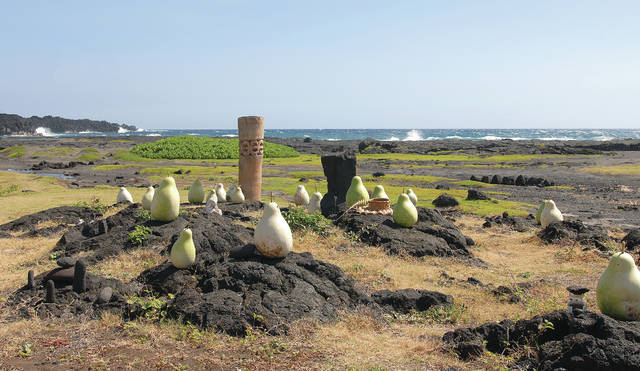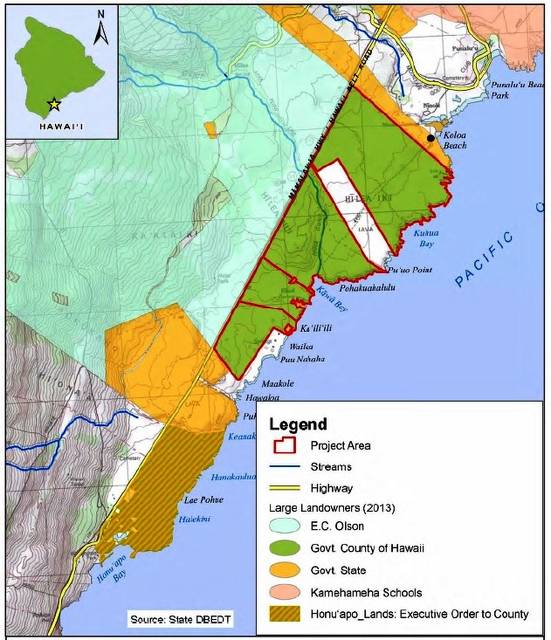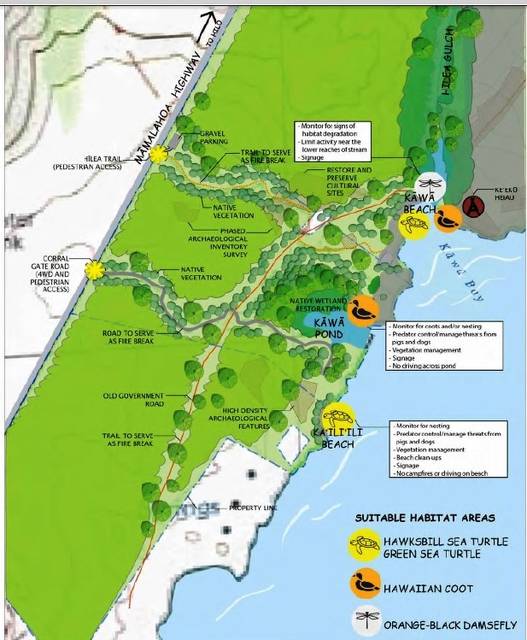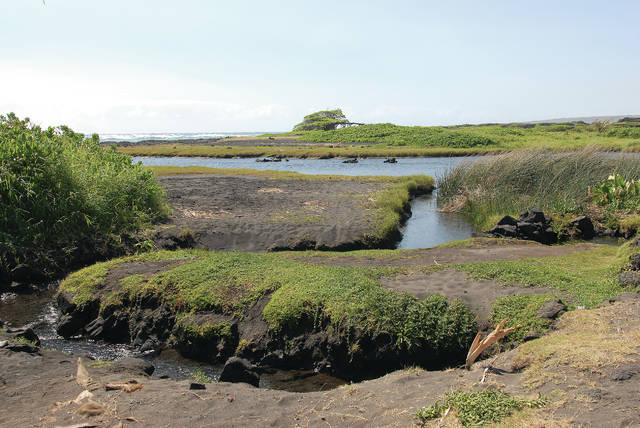Seeking balance at Kawa Bay: Community to weigh in on management plan
Controlling invasives and human activity in order to protect endangered species while honoring traditional practices and access rights are highlights of a management plan for county-owned lands along Kawa Bay that will be discussed during a public meeting this evening in Naalehu.
ADVERTISING
The plan attempts to strike a balance between activities that sometimes are at odds. It’s scheduled to be discussed at 7 p.m. at the Naalehu Community Center.
The 136-page report by consultant Townscape Inc., which cost $225,000 and took almost two years to develop, outlines short-term and long-term management strategies to maintain the 785 acres purchased with public funds.
“We definitely rely on the community to be involved in this project,” county Finance Director Collins Tomei said Tuesday. “We can’t do this by ourselves. It’s something the community can embrace.”
Management strategies are aimed at protecting four priority species: The hawksbill sea turtle, green sea turtle, Hawaiian coot and orange-black Hawaiian damselfly.
Returning the coastline acreage more closely to its former pristine state is a top goal.
“Ideally, the entire Kawa property should be restored with native vegetation, as the majority of the site consists of non-native or invasive plant species,” the report states.
At the same time, the county must honor court orders from 1980 and 2008 that reaffirmed public access rights, including by vehicle, to Kawa springs and bay. There also are native tenant rights stemming from when Kawa was a small fishing village.
“Unmanaged human activities are a significant threat to both the natural and cultural resources, as it can cause degradation of habitat for many native species,” the report states. “It is crucial that the county impose strict rules to protect resources at Kawa now and to avoid future risk of degradation.”
The report recommends limiting vehicular access from sunrise to sunset, prohibiting parking on the beach, moving the gate for the county access road more seaward of the highway with a small parking area and creating another small parking area farther from the road for kupuna and regular maintenance staff.
Portable toilets also are a necessity, it states, noting the strings of toilet tissue and other evidence of human defecation on the beach and in the bushes.
Consultants recommend a priority on predator control, as sightings of mongooses, rats, pigs and feral cats have been reported.
Effective maintenance procedures could require several hundred thousand dollars for controls such as traps, fencing and vegetation management, and an additional $150,000 to $200,000 annually for staff and maintenance, according to the report.
The project also relies heavily on volunteers and nonprofit groups to get down in the weeds.
Since 2014, Hawaii Wildlife Fund has worked monthly, removing invasive grasses from the Kawa estuary and Kaalaiki fishpond on the property. The nonprofit recently was awarded a grant of $13,200 that it could use for a project costing $36,744.64 in labor.
“Hawaii Wildlife Fund hopes that this restoration work will allow the native reeds (nanaku) and other native coastal vegetation … to repopulate and fill in the streambed and intertidal zones, thereby increasing the available dissolved oxygen in the estuary for aquatic organisms,” Vice President Megan Lamson said in the grant application.
Some residents, however, object to the ongoing work. One of those is Shelley Stevens Mahi, an advocate for Native Hawaiian land rights. She said native plants are being cleared from the site.
“There should be a site visit of Kawa Bay and (compare it to) what it used to look like,” Mahi told the Public Access, Open Space and Natural Resources Preservation Commission on Monday. “The bulrushes have been removed.”
Another opponent of the ongoing work is Abel Lui, who was evicted from the land in 2012. Lui, who built a house and erected tents where he and a group lived on the waterfront, maintained he was the caretaker of land passed down to him by his Hawaiian ancestors.
“There’s a conspiracy going on about selling our lands. They say they’re volunteers but they’re getting paid,” he told the County Council last month. “Everyone jump on the bandwagon and try to get grants on this. This is one racket.”
The 136-page report is on the web at https://goo.gl/aOxd4I.
Email Nancy Cook Lauer at ncook-lauer@westhawaiitoday.com.






